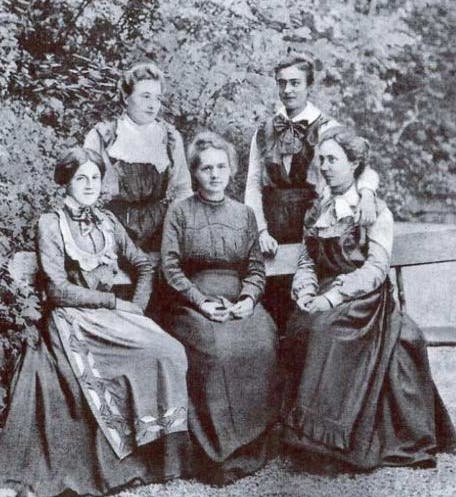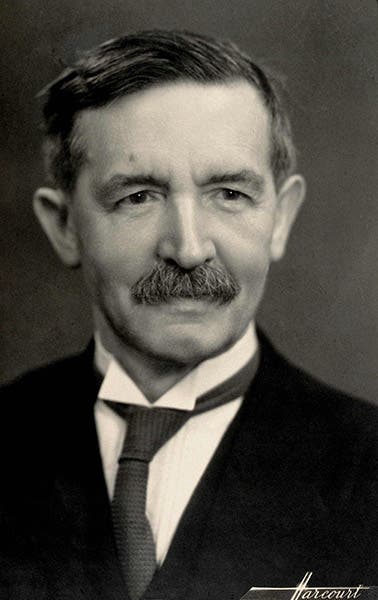Scientist of the Day - Eugénie Feytis Cotton
Eugénie Feytis Cotton, born Oct. 13, 1881, enjoyed two incomparable advantages for a young woman aspiring to be a scientist in 19th-century France. First, her parents encouraged her, ignoring provincial opinions in Soubise and straining their finances to provide her as excellent an education as they would have given to a son if they’d had one. Second, she studied physics in Paris with Marie Curie, from 1901 to 1903, at the prestigious École Normale Supérieure de jeunes filles, Sèvres, the country’s foremost female teacher-training institution (first image). As a bonus, Pierre Curie taught her to ride a bicycle, talking to her all the while about crystals and magnetism, which became Eugénie’s own research interest.
Beginning in 1903, the year the Curies shared the Nobel prize in physics with Henri Becquerel, the couple frequently called on Eugénie to baby-sit for their daughter, the future Nobelist Irène Joliot-Curie. The Curie circle – including Paul Langevin, Jean Perrin, other professors from the Sorbonne, and occasional visitors from abroad – embraced and advanced Eugénie’s entire career.
Having committed herself to teaching, she returned to her alma mater, the École Normale, as a physics instructor in 1905. She augmented many of the pedagogical practices introduced by Marie Curie, such as letting students derive their own results from hands-on experiments, instead of sitting passively through lessons and readings. Between them, she and Curie inspired at least two generations of women scientists.
Also in 1905, Eugénie Feytis began her own university studies at the Sorbonne, in what little time she could spare. It took her twenty years to complete her doctorate, given her teaching duties, her marriage to fellow physicist Aimé Auguste Cotton in 1913, and the tumultuous turns of world events. The births of her four children coincided with the Great War, so that the second boy, who arrived prematurely amid the privations of February 1916, died within days.
Like the Curies, the Cottons built their marriage on a foundation of science, love, and mutual respect. Aimé, twelve years older than Eugénie, was already an established figure when they met (third image). By the time she took his name, he had long since given it to the Cotton effect in optics and the Cotton balance for measuring magnetic field intensity. In time she lent her name to numerous schools and several streets in French cities, as well as to a crater on Venus.
Only once, the year before her wedding, did she take a formal leave from the École Normale to conduct research. She spent 1912-1913 working in Switzerland with electromagnetism expert Pierre Weiss. In Zurich, as in Paris, she was welcomed into the social milieu of Pierre and Jeanne Weiss, and heard Albert Einstein play the violin at their home.
If she failed to realize the promise Marie Curie had seen in her as a scientist, she exceeded all expectations in her efforts to make the École Normale the equivalent of any comparable academy for men. She kept her animated teaching au courant by consulting her wide network of contacts in European physics, which grew to include Niels Bohr. In 1936, when she took over as director of the school, she was the first doctor of science ever to serve in that position. On the brink of the second world war, according to Feytis family lore, she thwarted a German army officer’s intent to occupy the École Normale.
“In 1918,” the officer reminded her, “the French were in charge. Today it is we who command.”
“In 1918, I was not the director,” she replied. “Today I am, and I repeat that it is impossible to lodge your soldiers in a school for young women.”
Most likely the communist sympathies displayed by both Cottons figured in Eugénie’s forced retirement in 1941, at age sixty. She devoted the rest of her life to agitating for women’s rights and for peace. In 1961, on her 80th birthday, she received the Gold Medal representing the highest honor conferred by the World Peace Council. She died on June 16, 1967, at the age of 85, and was buried in the family plot in the cemetery in Sèvres.
Dava Sobel is the author of Longitude, Galileo’s Daughter, and, most recently The Glass Universe. She is writing a new book about the women who worked in Madame Curie’s lab.








